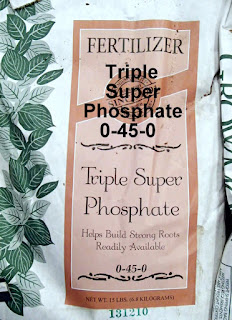Q. I wonder what fertilizer you
recommend for my fruit trees? The young trees I recently planted in my small
orchard are: plum, peach, apricot, lemon, pomegranate, plus several table grape
vines.
A. Lisa. Rather than just tell you what I would use, let me give you a little background on fertilizer selection.
To select the right fertilizer I am
supposed to tell you that you should test your soil for nutrients first and
then make your selection of fertilizer based upon the test results. That's the
right answer but it's not always the most cost effective thing to do if you
will have only a few trees. The soil test would cost about $75. You can buy a
lot of fertilizer for $75. It makes sense to do this if you are a farmer and
spending thousands of dollars on fertilizers and you want to get the most
"bang for your buck" but for homeowners it doesn't make a lot of
sense.
Mineral or Conventional Fertilizers
Most of our soils will support the
use of mineral fertilizers from a bag for many years if we have the soil
covered with wood chips that slowly decompose in the irrigated areas. If the
fruit trees are surrounded by rock on the surface of the soil than the proper
fertilizer selection becomes more critical.
Let's say you have your fruit trees
surrounded by woodchips. Fruit trees planted in lawns could be put into this
category as well. Just be careful of irrigating the 2 together because they
have different water requirements. If the trees are surrounded by rock instead
of woodchips, they are growing in the soil that's more similar to hydroponics.
Fertilizer selection is more critical when fruit trees are surrounded by rock.
Numbers on the Bag of Fertilizer
Mineral fertilizers have 3 numbers on
the bag. If the fruit trees are less than 3 years old, use a fertilizer that
has the first and third numbers highest. The middle number, phosphorus, can be
lower than the other 2. If the fruit trees are starting to produce fruit, use a
fertilizer that has all 3 numbers the same value. Use this fertilizer only once
at the beginning of the growing season and apply it about 2 weeks before the
flowers appear. In Las Vegas, this would be about the middle of January to 1
February. For grapes, this would be about a month later.
 |
| Bag of conventional fertilizer called to Flower Power with 3 numbers denoting nitrogen, phosphorus and potassium |
Application of fertilizer is frequent enough
unless you have very sandy soils. But if you decide to make a second application,
and the trees are surrounded by wood chips that are decomposing, only apply a
high nitrogen fertilizer. This would be a fertilizer that has only the first
number on the bag and the other 2 are zeros.
Phosphorus
Phosphorus, the middle number on the
fertilizer bag, sticks in the soil a lot longer than the other 2. Phosphorus is
the only one of the 3 listed on the bag that can create some problems in the
future if this mineral is continuously applied, over and over. This is the
reason I recommend that people have 2 mineral fertilizers on hand. One
fertilizer high in phosphorus, the middle number. And the other one high in
nitrogen, the first number. The last number, potassium, should be as high as
possible in both fertilizers. Potassium is a little bit more difficult to find
in bags of fertilizers.
Compost As a Fertilizer Substitute
 |
| When adding compost as a fertilizer, use a rich compost and keep it away from the trunk of the fruit tree at least 12 inches away. |



For the compost, is rejuvenate your favorite?
ReplyDeleteActually I like the 166 aka Viragrow Compost, from Viragrow the best for all around results.
DeleteI have seen the 166 compost last for three years when it is mixed in at planting.
Deletethanks
Delete